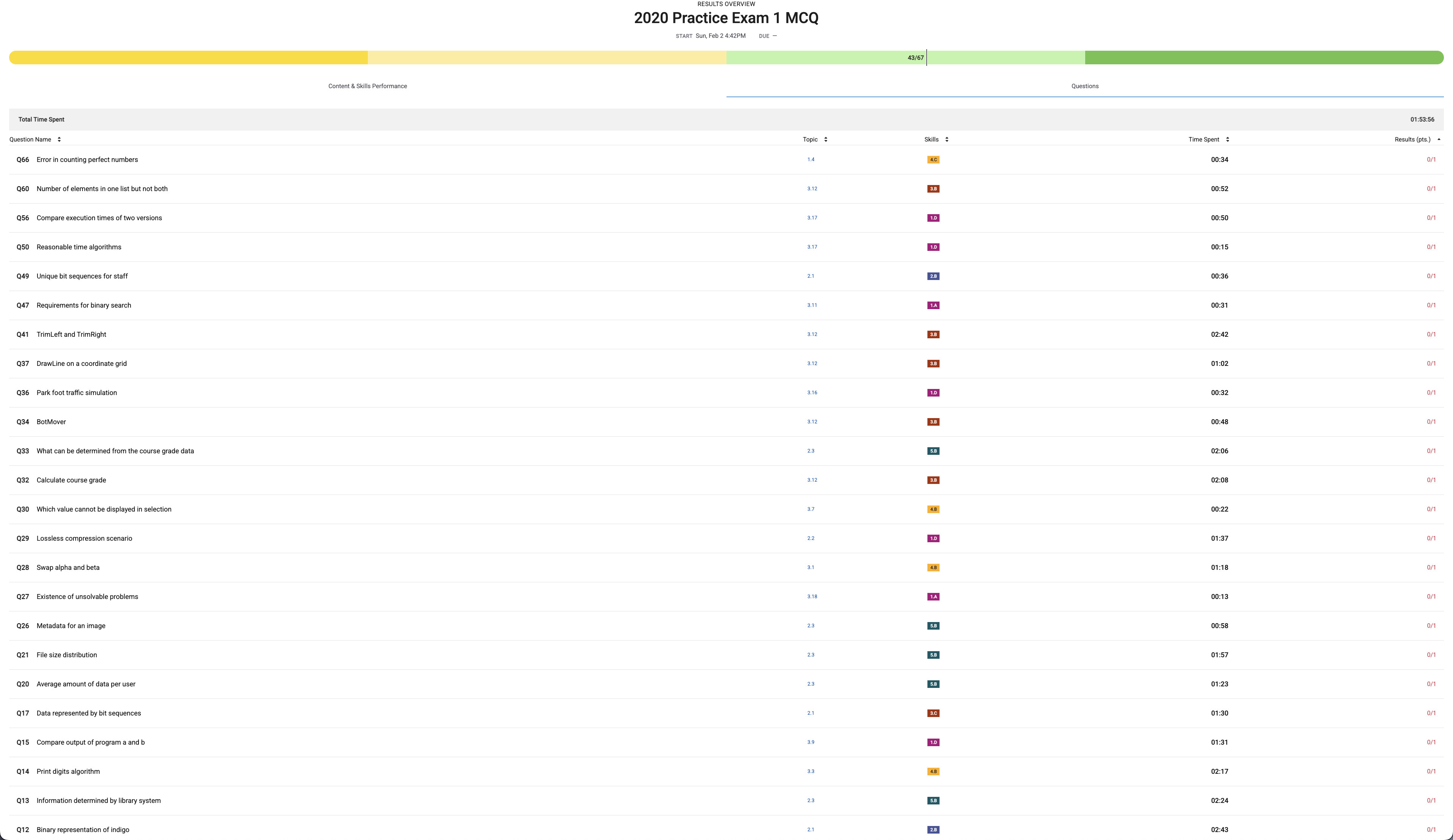MC:
Score: 53/67 (79.1%) Time:

Topic Skill Performance Errors:
- 1.4: Identifying and Correcting Errors: 86% (6/7)
- 2.1: Binary Numbers: 40% (2/5)
- 2.2: Data Compression: 0% (0/1)
- 2.3: Extracting Information from Data: 29% (2/7)
- 3.1: Variables and Assignments: 0% (0/1)
- 3.3: Mathematical Expressions: 0% (0/1)
- 3.7: Nested Conditionals: 50% (1/2)
- 3.9: Developing Algorithms: 75% (3/4)
- 3.11: Binary Search: 0% (0/1)
- 3.12: Calling Procedures: 0% (0/5)
- 3.16: Simulations: 50% (1/2)
- 3.17: Algorithmic Efficiency: 0% (0/2)
- 3.18: Undecidable Problems: 0% (0/1)
Corrections: Q12: Incorrect Binary Representation. E.g. 00100101 = 2^0+2^2+2^5 = 32+4+1 = 37.
Q13: Didn’t quite understand the questions. Should have been B because the system only has information for books that were borrowed. Books that have never been borrowed are not represented in the data. Do not assume.
Q14: With this step, the algorithm will result in an infinite loop (unless number is a multiple of 10). For example, if the input is 512, the algorithm will display the integer quotient 51, then store the remainder 2 in number, then display the integer quotient 0, then store the remainder 2 in number, and so on. If number is a multiple of 10, the algorithm will display the result of dividing number by 10 and then terminate.
Q15: While the two programs initialize i to different values, the same values are printed inside the loop because program A prints i and then increments it and program B increments i and then prints it. Program A initializes i to 1. Inside the loop, it prints i and then increments i. The loop terminates when i is greater than 10, which occurs after 10 is printed. Program A prints 1 2 3 4 5 6 7 8 9 10. Program B initializes i to 0. Inside the loop, it increments i and then prints i. The loop terminates when i equals 10, which occurs after 10 is printed. Program B prints 1 2 3 4 5 6 7 8 9 10.
Q17: III is also correct because at the lowest level, all digital data (including machine language instructions) are represented with sequences of bits, meaning at the lowest level, all digital data (including integers, alphanumeric characters, and machine language instructions) are represented with sequences of bits.
Q20: Didn’t analyze correctly. Should have been A because each value on the right line graph is about 10 times the corresponding value on the left line graph. Therefore, the average amount of data stored per user is about 10 GB.
Q21: Didn’t calculate accurately. SHould have been B because the files that are up to 10 MB represent 17% + 24% + 25% + 10%, or 76%.
Q26: Metadata is data about data, so it’ll not likely have a duplicate copy of the data as it isn’t descriptive, such as copyright information.
Q27: Problems CAN be solved computationally without Internet connection, however, there are some problems that cannot be solved using any algorithm. These problems cannot be solved computationally.
Q28: Mixed up the order. Should have been I and III only.
Q29: Deleting some data then transferring is lossy. Compressing then transfering then restoring is lossless compression. Lossy compression reduces file size by discarding some data, while lossless compression reduces file size without losing any data.
Q30: Selected wrong. Cannot work if the values are out of the range. However, “out of range” isn’t possible because it is a prereq to the previous if else, so it will ALWAYS be in range.
Q32: Didn’t correctly understand the questions. Should be D because the code segment takes the sum of the individual scores and subtracts the lowest score. To obtain the average, the result is divided by one less than the number of scores (since one score was dropped).
Q33: This can be calculated, the vaule of the highest score cannot be because individual assignment scores are not shared.
Q34: Incorrect because it’ll move off the grid - be more attentive.
Q36: Older vs newer models are not related to the amount of time it’ll take to run a simulation. They are changing the complexity, which’ll allow for a lesser run time as it’s less detailed.
Q37: Incorrect because it wouldn’t draw the correct pieces. Rather, A draws the 4 correct segments.
Q41: III also because do the same as I just in a slightly different manner.
Q47: A binary search works on any sorted list, regardless of duplicate values. It just must be sorted.
Q49: Binary - counted incorrect. 6 bits = 2^6 which is 64. 7 bits = 2^7 = 128.
Q50: I, II, and III because Algorithm I accesses elements times (twice for each of n elements), which is considered reasonable time. Algorithm II accesses elements (n times for each of n elements), which is considered reasonable time.
Q56: Verson II actually takes longer because it’ll call GetPredition twice for each element while Verson I only calls GetPredition once, so verson II will take longer than version I.
Q60: Incorrect because it’ll produce the wrong result. D is correct because it creates newList1, containing the unique elements from list1, and newList2, containing the unique elements from list2. These two lists are combined to form bothList. Any elements that appear in both lists are removed from bothList to form uniqueList. The correct count is the difference between the lengths of bothList and uniqueList.
Q66: Error in recognizing nested loops. Should have been line 9 because every integer from start to end should be checked, so currentNum should only be incremented inside the loop but outside the body of the IF statement.
Next Time:
- Binary starts w 0 - 2^0, 2^1, 2^2, etc
- be more attentive
- test the procedures
- double check
- read carefully